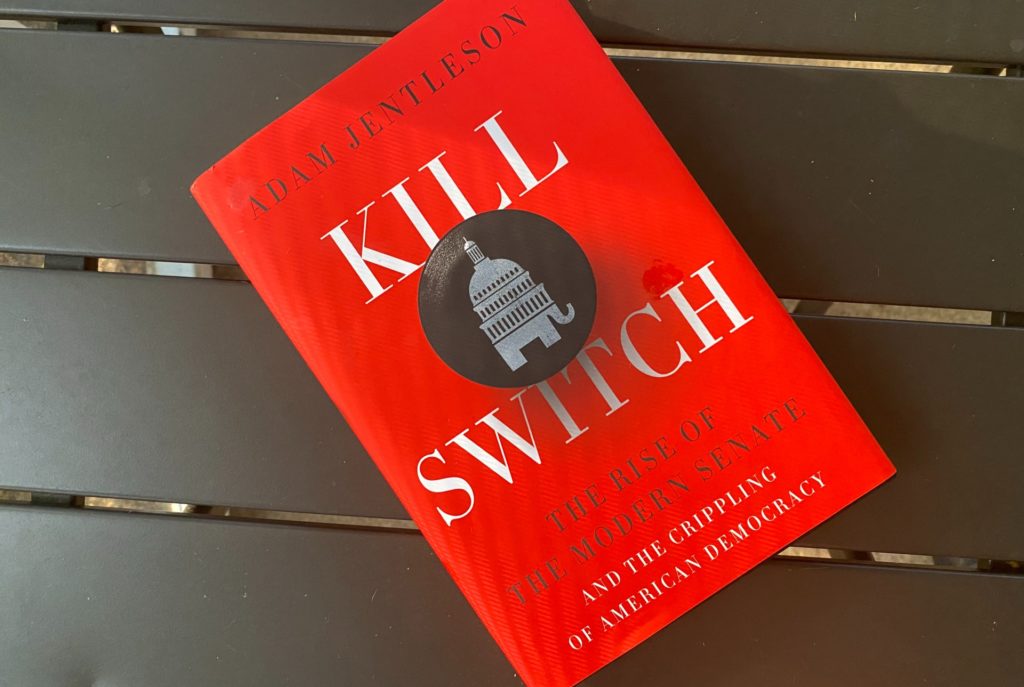Book Review: Kill Switch
Discussing the filibuster.

Adam Jentleson’s 2021 book Kill Switch: The Rise of the Modern Senate and the Crippling of American Democracy is an extremely readable and worthwhile look at the evolution of minority rule in the US Senate. It focuses, specifically on the development and growth of the filibuster. Jentleson served as Senator Harry Reid’s (D-NV) deputy chief staff, so he has direct knowledge of Senate operation, but also a partisan point of view (although I do not think it affects his analysis–he does not come across as partisan in the text, although he clearly has a point of view on this topic). He is currently a writer and columnist.
The book is timely, as it provides insights into a key aspect of American governance in recent times: the shift of the US Senate, an already counter-majoritarian body due to the way seats are allocated to the state, into a body that essentially requires 60 votes for actions other than nominations and budget reconciliation.
The book is split into two parts. Part I is more historical and is called “Rise of the Filibuster” while Part II is a bit more focused on recent events and is called “Tyranny of the Minority.” I found Part I more focused as it took a more narrative and linear (although not fully so) approach to the early development of the filibuster. Part II at times feels more anecdotal about Jentleson’s own time in the Senate, although it does jump back in time to recount relevant historical developments to explain current behavior. Although for what it is worth, I took more notes from Part II, and all but one quote in this review is from that section.
I will admit that I would have preferred a more thorough linear historical account of the filibuster’s development, as I know some aspects of changes to the rules under Robert Byrd’s leadership are not well discussed. The political scientist in me would have also preferred more numbers about the increase in usage of cloture votes/procedural filibusters over the last two decades.
Still, as noted above, I recommend the book, especially if one is not especially familiar with the history of the procedure. A key theme that is worth point out: from the 19th Century into the 1960s, the filibuster was used as a means of trying to block civil rights legislation all under the guise of “minority rights” and a focus on free debate. In other words, Senators, especially from southern states, built up a mythology about debate and the rights of the minority as a cover for what were really attempts to either protect slavery or to stop civil rights legislation. This dates back to John Calhoun, who pioneered tactics that become key in the post-Civil War Senate.
According to Jentleson, “From the end of Reconstruction in 1877 until 1964, the only bills that were stopped by filibusters were civil rights bills” (108). Indeed, despite a lot of mythologizing (that continues to the present day) about deliberation and the rights of Senators to be heard, the filibuster has its origins as a tool for squelching the rights of the Black minority in the United States. This is not hyperbole and paves the way for some serious reevaluation of the procedure from 1964 back.
The current story of the filibuster is a more recent one linked to simple obstruction by the minority party, more often by the Republicans than by the Democrats. This stands to reason from a partisan POV, as “The modern Senate creates a structural advantage for conservatives because its rules have evolved to make it incredibly easy to stop legislation” (124).
There are two key strands of the tale, one about nominations and the other about general legislation.
The nomination issue is linked to the original invocation of the so-called “nuclear option” by Harry Reid during the Obama administration to allow nominations (except for the Supreme Court at the time–this was late changed by Mitch McConnell) to pass on a simple majority vote. This was in response to Republican obstruction of Obama nominees: “By the time Reid went nuclear, half of all filibusters against nominees in the history of the United States were waged by Senate Republicans against Obama’s” (116). Reread that sentence if you skimmed it and let it sink in.
Jentleson notes that delays were not over principled objections, but were for the purpose of delay, citing the example of a filibuster against Chuck Hagel’s nomination for Secretary of Defense (for those who have forgotten, Hagel was a Republican Senator). “A study by the nonpartisan Congressional Research Service found that under President Clinton, unanimous judicial nominees—those who ended up having zero votes cast against their nomination–waited an average of 17 days to receive the confirmation votes. Under President George W. Bush, the wait was 29 days, under President Obama, it was 125 days” (118).
As it pertains to legislation, all that has to happen is for a Senator, anonymously, to object to a bill for it to be blocked, and hence the silent filibuster instead of the talking variety (210). “[T]o deter a leader from moving forward, all a senator had to do was signal their intent to filibuster” (211). Specifically: “One phone call, one objection, and the threshold on any bill or nomination goes from a majority to a supermajority” (211). Why this is the case is detailed in the book.
This situation is, it should be noted, a paradise for any party who doesn’t want change and is content with the status quo, especially if that party represents a minority of the overall population. Along those lines, “In the twenty-first century, Senate Republicans have represented a minority in the population every year, despite holding as many as fifty-five seats, as they did from 2005 to 2006. at their low point this century, in 2009, Senate Republicans represented just 35 percent of the population” (126).
And before someone blindly cites design or, more specifically, small states v. large states, “The fact that small and big states are evenly represented by Democrats and Republicans shows the dysfunction in the modern Senate does not lie in its built-in bias toward small states. Instead…it lies in the way the rules have evolved to give certain groups of people–as opposed to states–more power” (128).
In other words, both the myth that the filibuster makes the Senate more deliberative and the myth that is just helps out small states, are both nice-sounding fallacies.
At any rate, I would highly recommend the book for anyone interested in better understanding how the rules of the Senate are affecting democratic governance in the United States.
For those interested, I would also recommend the episode of the podcast Politics in Question, Did the Filibuster Break the Senate?, wherein Jentleson appears. The conversion is both informative and interesting although I will admit to being a bit frustrating to me because I think, as is often the case with discussions of American politics by Americanists (all three hosts hold Ph.D.s in political science and focus on American politics), it was too focused on personalities and not enough on how the rules and structural conditions of the Senate shape the options available to politicians and, therefore, explain their broader behavior.
The back-and-for with James Wallner, a political scientist who once worked on the Republican side of the Senate is interesting insofar as Wallner frequently argues that the filibuster alone is the problem in the Senate and that the majority has other tools it is choosing not to use. I respect his knowledge of the rules, which far outstrip my own, but I tend to find his arguments about the filibuster to be unsatisfying. I would note, however, that he largely endorsed Jentleson’s basic thesis.






I’m glad you posted this Dr. Taylor as I’ m debating what book to read next and this one as been on my radar for a bit. Will be picking this one up.
That really is quite a sentence. Silently, unaccountably shutting down an opposition President from doing, well, much of anything.